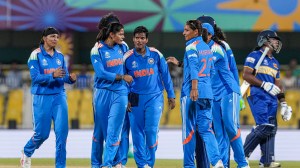Breaking the sound barrier
Discoverer of a new flute. That's how flautist Keshav Laxman Ginde will be remembered, and wants to be remembered, though he is a qualified ...

Discoverer of a new flute. That’s how flautist Keshav Laxman Ginde will be remembered, and wants to be remembered, though he is a qualified mechanical engineer, working for Kinetic Honda, Pune. The young boy who started learning the flute when he was 10, in Belgaum in 1952, recently got his name etched in The Limca Book of Records (1998) as a flute-innovator.
“Years of experimentation have finally borne fruit,” says Ginde with satisfaction. He has cheerful memories of his first flirtation with the flute. He trained under Narayanrao Borkar, who played for Dinanath Mangeshkar’s troupe and Bal Gandharva’s drama company. Later, he trained under the late Haripada Choudhari and Pandit Devendra Murdeshwar, disciples of renowned musician Pandit Pannalal Ghosh.
Today, Ginde may be an accredited Grade `A’ artiste, playing regularly for All India Radio and Doordarshan and giving stage performances, but he recalls his struggling days with a smile. “My most memorable performance was in 1960, my first performance, on the 75th anniversary of Fergusson College, presided by Dr Rajendra Prasad, C D Deshmukh, Y B Chavan. I performed for a 10,000-strong crowd. Another stage performance which I can never forget was at Ajmer. I begged the organisers to let me play for 15 minutes. But after seeing my performance, they wanted to hear more, and the next day, I was scheduled three hours. I cherish that memory.”
“Those days, we played the horizontal flute, the venu,” he says. The flute is a 16-inch long, slim, bamboo instrument, with seven holes (six for playing and one for blowing), traditionally in use since Vedic times. “Ghosh was not too satisfied with the traditional flute as it was very difficult to play the notes smoothly, the break between the notes ma and pa was obvious. Ma is played with six holes open and pa with all six holes closed. Due to this discrepancy, it takes the flute away from singing,” explains Ginde in detail.
Eventually, Ghosh invented a 32-inch-long flute, with an extra hole. “Even with this innovation, raags like Darbari and Malhar were still unplayable, so Ghosh used two flutes (an additional Khurja flute) while performing. With this he could play the three-and-half octaves, but with a little discomfort,” says Ginde. However, where do Ginde and his innovation come into all this?
All this while, Ginde was following Ghosh’s invention religiously, thinking that nothing could better it. However, his restlessness with its inadequacy led him to first abandon flute-playing altogether. But with the blessings of his spiritual guide, Guru Ramkrishna Kshirsagar of Ahmednagar, and with the blessings of Lord Dattatraya, whom he believes in, he regained his form and fervour.
He attributes his successful innovation to this spiritual direction. “My guru told me – nothing doing, keep playing. You are going to do something. This helped me in researching my innovative ideas,” says Ginde. The new flute, which he named Keshav Venu, was on its way to being redesigned in 1990, but finally took shape in 1995. Keshav Venu has 12 holes, is 42 inches in length, with a one-inch diameter.
So finally here’s a 3.5-octave flute which sounds like a melodious human voice, which can play all the classical raags comfortably. Definitely a record to record!



- 01
- 02
- 03
- 04
- 05




























